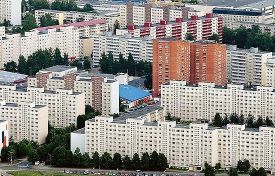Analytics, Baltic, Financial Services, Loan, Real Estate, Wages
International Internet Magazine. Baltic States news & analytics
Friday, 19.04.2024, 18:40
Housing affordability increased in all Baltic capitals in Q1
 Print version
Print version |
|---|
Improvement in the index has been driven by a strong wage growth and the drop of average apartment prices against the respective period last year.
In the first quarter of this year the HAI in Riga has achieved the highest value since 2005 – 166.5 points which is by 15.1 points more than a year ago. The HAI value of 166.5 for Riga means that household income in the fourth quarter of 2015 was by 66.5% higher than needed for a housing loan that costs no more than 30% of the family's net income. The index improved thanks a 5.2% growth of the average net wage, and a 4.6% drop of the average housing price. Housing interest rates though have slightly risen by two base points from the first quarter of last year.
Despite the improvement of housing affordability, the activity of residents in the housing market stagnates, remaining at the 2013-2014 level, said Swedbank’s economic Andrejs Semjonovs. Activity remains weak despite increase of the number of transactions in the state support program for families with children in purchase of their first housing. The transactions under this program account for about 15% of the total number of transactions in the market compared to 7-8% in 2015.
In Tallinn, the HAI improved to 153.7 points compared to 143.6% in the first quarter of last year. The improvement has been achieved thanks to a considerable growth of net wages by 8.5%. Apartment price growth has slowed down to 0.7%. Interest rates on loans have risen by five base points.
"In Tallinn, the real estate market has cooled. First-quarter data for 2016 indicate that annual growth in apartment prices has almost come to a halt, having decelerated to 0.6%. The slowdown also includes market activity, where the year on year growth in the number of deals decelerated to 7%. Moreover, preliminary data suggest that in April and May fewer transactions were made than a year ago," Swedbank said.
In central Tallinn, the beginning of the year showed some price recovery, but annual growth there has been negative since November, with the exception of February. This is being compensated for by stronger growth in the other major regions of the city, such as per-annum growth of 6% in Lasnamae and of up to 14% in Mustamae in the first quarter.
The supply of newly constructed apartments remains high. At present, there are about 100 active apartment building projects in Tallinn: some are completed, with few unsold apartments, whereas others have just started advance sales.
The number of issued building permits for apartments has been gradually decreasing for three quarters in a row, but remains higher than the long-term average. In each of the last four quarters, on average, the construction of about 600 apartments was physically started. Meanwhile, the price gap between newer and older apartments has been narrowing for a whole year, making newer apartments more attractive.
On the other hand, consumer confidence to purchase or build a home within the next 12 months has been declining for three successive quarters. In the first quarter of 2016, year on year growth in the turnover of housing loans slowed down to 5%. Despite strong wage growth and low interest rates, the turnover of housing loans in March and April was smaller by respectively 4% and 7% that in the same month last year.
The total loan portfolio is still growing at a modest pace or 4.2% per year. The supply of new apartments will remain high in the near future, whereas consumer confidence to purchase a home shows some signs of hesitation. This is estimated to keep apartment prices under pressure and price corrections more likely for older apartments with higher maintenance costs.
Compared to the first quarter of last year, the HAI in Vilnius has risen by just 0.5 points to 132.3 points. The slight improvement had been thanks to the steep rise of net wages by 7.1%, however, apartment prices also rose by 6.8%. Interest rates on housing loans declined by one base point.
The time needed to save for a 15% down payment decreased by 2.4 months in Riga to 23.5 months, by 2.2 months in Tallinn to 28.5 months, and by 0.2 months in Vilnius to 35.8 months.
Swedbank publishes its Baltic Housing Availability Index quarterly. The HAI reflects household buying power, based on apartment purchases that have been made, but says nothing about opportunities for apartment sales. It includes mortgage costs but excludes taxes and subsidies, including property tax and interest deductions, as well as housing maintenance costs such as utility bills.
The HAI is calculated for a family whose income is equal to 1.5 of average net wages with an average-sized apartment of 55 square meters. The HAI is 100 when households use 30% of their net wages for mortgage costs. When the HAI is at least 100, households can afford their housing, according to the established norm. The higher the index, the greater the affordability.








 «The Baltic Course» Is Sold and Stays in Business!
«The Baltic Course» Is Sold and Stays in Business!

